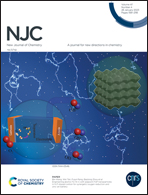Tunable emissive carbon polymer dots with solvatochromic behaviors for trace water detection and cell imaging†
Abstract
Carbon polymer dots are a kind of emerging carbon dots and generally synthesized by a bottom-up method. Because of the diversity of the reaction processes and product structures, the luminescence of carbon polymer dots is different, which induces indeterminate luminescence mechanisms. Hence, confirming the luminescence mechanism of carbon polymer dots is significant for developing applications. In this work, the prepared carbon polymer dots exhibited solvatochromism after dissolution in different solvents. Then, after theoretical model analyses, it was found that the emission of carbon polymer dots was derived from molecular luminescence related to hydrogen bond effects. In addition, the luminescence of carbon polymer dots was mainly affected by hydrogen bonds between the surface groups of carbon polymer dots and the solvent molecules. Moreover, detection of trace water in organic solvents was realized based on the super sensitivity of carbon polymer dots to the polarity of organic solvents. And, using different polymers, which had different strengths of hydrogen bonding, modified carbon polymer dots were prepared for multi-color cell imaging. This work not only reveals the luminescence mechanism of carbon polymer dots synthesized using phenylenediamine as the precursor but also explores the detection and bio-imaging applications of carbon polymer dots synthesized from small molecules.



 Please wait while we load your content...
Please wait while we load your content...